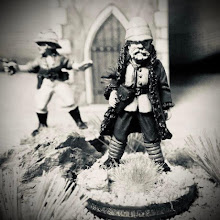In the finest traditions of Hollywood, the heroic conclusion! Originally posted on July 14, 2021:

Recap: A British Indian Army force has been tasked (using the rules The Men Who Would be Kings) with capturing a railroad bridge in order to disrupt Imperial Russian supplies from reaching the Princely State of Chaimbellistan. Though superior in numbers, the British Indian force has sustained heavy casualties primarily due to a Russian Maxim machine gun and the marksmanship of the 21st Frontier Guard Company. Two British officers have been killed but the much reduced 19th Punjabis have chased the Russian Naval Brigade off the bridge. Three turns to go to decide victory and defeat.The Indian Army Maxim finally resumes it movement. Machine guns are slow at 4 inches for their maximum move making them difficult to use in an attack that takes lots of movement instead of having them in a convenient firing position.
With a LV of 6+, Colour Sergeant Smith fails to successfully move the Royal Fusiliers toward the bridge to support . . .
. . . the 19th Punjabis who have occupied the key objective. But can they hold?
Subedar Major Ajeet Deol organizes the defense. The positioning of the figures is purely for show since units can see 360 degrees (large skirmish game) and most can shoot 360 degrees in The Men Who Would be Kings. The exceptions are infantry in Close Order and crew served weapons that can shoot 180 degrees to their front based on their facing.
The 14th Sikhs, now under half strength, rally.
Again? The officer commanding the 21st Frontier Guard Company Leadership Trait is "Idiot". He was going to order an advance on the 19th Punjab but has to roll a die first due to his Leadership Trait. Sure enough, he rolled a "1" and the British Indian player gets to decide what order they obey if the activation is successful.
"Advance to the rear!"
The Naval Brigade Officer has the Leadership Trait "Coward" and the Punjabis are within a move distance so the Naval Brigade has to move away from the 19th. Events are rapidly collapsing for the Russians.
And then the Maxim fired eliminating half of the defenders on the bridge.
Fortunately for the Punjabis, they are not pinned.
The 14th Sikhs make it to the tree line.
The machine gun finally gets into a position where it is in range of the Russians.
Colour Sergeant Smith leads the Royal Fusiliers forward to reinforce the 19th Punjabis."Private McGillicuddy. Fix your helmet in the face of the enemy! How many times do I have to tell you about regulations?"
Yep it's the Russians turn and that Maxim is taking the 19th Punjabis apart at close range.
The Subedar Major is the lone survivor but he is not pinned. (I must have hit his face accidentally with some brown paint. It's funny what you don't notice until you see it in a photograph. After the battle he is going to the medical tent so I can fix his face!)
The tide may be turning as the fierce 21st Frontier Company returns to the fray. By the way the Naval Brigade made it to the cover of the woodline.
Destiny awaits. The final turn.
"Fire at the enemy machine gun!"
The British Maxim is successful in hitting two crewmen. The officer is not hit even though he is laying down; just showing that there are two casualties.
Uh oh. The Fusiliers fail to activate and move to the bridge.
The 14th Sikhs use their free action of Fire and hit the Russian machine gun.There is one casualty - the officer in charge!
The black die designates the machine gun as pinned and the white die is showing that there is only one crew left.
"Sigh". That Leadership Trait is killing me."Okay boys, back the way we just came."
The "Cowardly officer" fails in his order to move the Naval Brigade away from the Subedar Major.
The Russian machine gun fails to rally . . .. . . and must abandon its position.
Victory goes to the the British Indian Army - but at a price.
All in all a nail biter of a battle. Talk about grabbing defeat out of the jaws of victory. I really thought the Russians were going to pull it off with the Maxim and the Frontier Guard - until the "Idiot" Leadership trait kicked in. The 21st could have easily overwhelmed the depleted 19th Punjabis. What was it? Four or five "1's were rolled causing confusion and keeping the 21st out of the battle. That's the stuff legends are made of! Colonial gaming with a Hollywood flair.
The Leadership traits really add a fun dimension to The Men Who Would be Kings - it can really alter your plans. My plan as the Russians was to have the 21st and the Maxim create an engagement area to keep the enemy away from the bridge while the Naval Brigade would shoot for all it was worth until the enemy got close - and it almost worked.
The British plan was an attempt to fix the Russians to the front and then flank either side depending on who was having success. What they did not count on was the lack of firepower from their own machine gun because of it's slower speed. Gee, just like in real life. But once it got in position - Yikes! Both Machine guns were the killers on this battlefield.
Subedar Major Ajeet Deol is awarded the Indian Order of Merit (IOM), 3rd Class, for his conspicuous act of individual gallantry in the field against overwhelming odds in capturing the bridge and significantly contributing to the war effort.
Indian Order of Merit, 3rd Class
























































